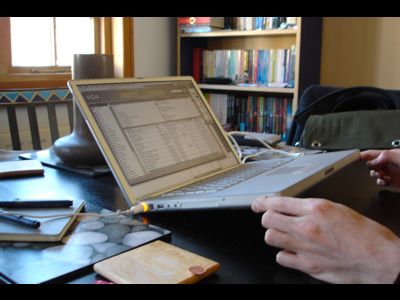The Hills Are Alive with the Sound of Interaction Design
Image: bumptunes photo by Timo Arnall.
When the Apple Powerbooks with built-in sudden-motion sensors came out, Amit Singh came up with a way to tap into the output of the accelerometer [see ‘amstracker’]. My friend Timo Arnall came round to my house with his new computer, and we rigged a way to slap the computer to make it play the next tune in iTunes. You’d slap it on the side to jump ahead, and on the other side to jump back. This is me experimenting with different interactions there. We called it bumptunes.
That was, gosh, almost 2 years ago. There are now applications to make this much, much easier.
Here’s the great thing:
If you use these methods of interacting with your computer, it’s like the day you first used WYSIWYG: You wonder why it wasn’t this natural before… and when it goes away, it’s frustrating. When Timo took his laptop back, I did spend a while slapping my own laptop, trying to change tune, wondering why it wasn’t learning and if the script had crashed. Of course, I just didn’t have an accelerometer and I was sitting there, progressively voiding my warranty.
I have a Nintendo Wii now, and after I play it, I find myself trying to channel surf on my TV by waving the remote control around. Enormously frustrating. Same thing.
Tangible interactions can be more immediately familiar than ones we regularly use with our computers.
